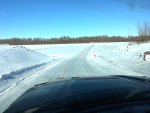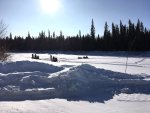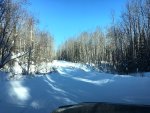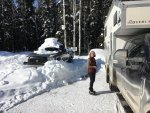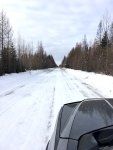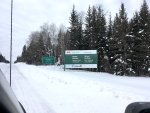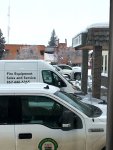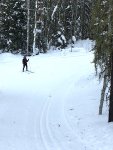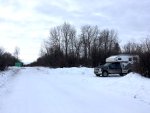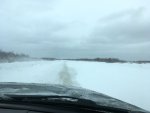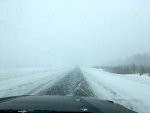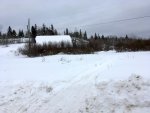Trail Talk
Well-known member
When we acquired our OEV Summit from Lite Industries in the fall of 2020, our expectations were for a true four season unit with the chops to travel the Canadian North during our deep, dark winters.
Previous travels to the Arctic Ocean in summer impressed upon us the need for a robust, reliable and readily serviced platform so the choice of a domestic truck with suitable GVWR was a no-brainer.
The marriage of OEV’s premier Summit composite cabin with an F350 4x4 cab chassis seemed to answer our needs. Nevertheless, we took a year and a half to get familiar with the rig over several adventures during all seasons. This shake-down time was most worthwhile as we sorted a few glitches, but finally we were confident enough to tackle THE trip; the winter road to Fort Smith, Northwest Territories.
Winter roads in northern Canada have always fascinated us. As life-long residents of the city dubbed “Canada’s Gateway To The North”, we were taught in school about the fur trade and the use of rivers as highways through the barren landscape. For a couple of months each winter, when the ice was sufficiently thick on the rivers, dog-sleds would venture along their frozen surface. Nothing much has changed today for many remote settlements except canoes and dog-teams have been replaced by motorboats and snowmobiles.
Along a few select routes, crews and equipment prepare ice highways over the swamps, muskeg, creeks and rivers by pumping water on the frozen surface until a suitable thickness is achieved. These are stitched together by stretches of land wherever possible. During a brief and variable period each winter, entire communities are re-supplied for the coming year via the winter roads, at a fraction of the cost of air transport.
To prepare ourselves, we reviewed the highway department’s winter road safety tips; “Prepare for the worst, experience the best. Avoid traveling in winter storms as storms mean poor driving conditions and visibility. Conditions can change quickly. Make sure you are ready for whatever comes your way. Any delay or breakdown can quickly become life-threatening.”
Thus filled with confidence, we departed our home base one morning at the tail-end of February knowing that last season’s winter road was closed mid-March. Preparations were scant; a couple of jerry cans were filled with reassurance gas and an interior cargo net was installed in the rear seating area of our super cab, where some heavy gear was being carried. I packed snow chains but was relying on studded winter tires to deal with most situations.
The roadway gradually turned from dry pavement to fresh, wet, snow as we motored north towards our first stop of Fort McMurray, the hub of Alberta’s oil production. The lone highway accessing Fort Mac from the south is notorious for traffic fatalities as rig workers race up and down its 435 kilometres; impatient not to waste a single minute of their downtime. Death is forever, I’m thinking as another pickup flies by in the snow and ice-covered left lane…
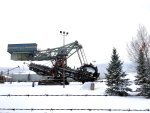
To confess, this was our first trip to Fort McMurray and I was pleasantly impressed by the scenic Athabasca river valley bisecting the town. The cross-country ski facilities, some 30 km of groomed, wooded trails, invited us to take a day off and enjoy. An enormous vintage dredge at the Oil Sands Discovery Centre was clearly visible as we entered town but, unfortunately, was closed during the time of our visit.
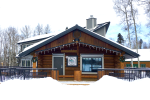
Our night at the one RV campground open during winter was, as expected, empty of other tourists; occupied instead by units in storage and a handful of worker’s trailers, skirted and plumbed, for those few who chose not reside at the huge work camps outside of town. We would have preferred one of the provincial campgrounds but all were closed for the season. Regardless, the commercial RV park offered clean, warm shower and laundry facilities.
The real adventures began with the next leg of our travels, north to Fort Chipewyan. It started as a divided two-lane highway that services the gigantic oil sands extraction fields. After 80 km of sharing space with trucks big and small, the highways ends at a narrow track heading into the bush.
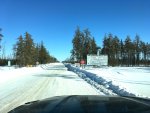
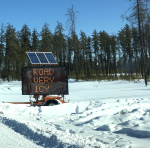
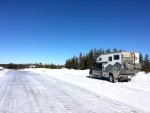
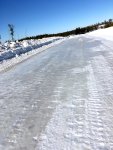
Fort Chipewyan is 160 km up the winter road and a further 16 km detour to the shores of Lake Athabasca. The community is only accessed by air or boat in summer and ice road in winter. Established as a fur trading post in 1788, it is also the oldest settlement in Alberta and remains the centre of First Nations activities in the region.
As we arrived under cold, bright blue skies we could easily observe the town buildings across the frozen lake and were puzzled by an unmarked branch which offered a more direct route to the settlement. Deciding to take this, I immediately sensed the surface heaving and creaking as we slowly motored along. At the other end a fellow driving a town vehicle congratulated us for braving their unofficial short-cut.
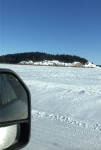
We took a tour through town while looking for gas and were impressed by the quads and snowmobiles sharing the streets. As I was stopped trying to figure out google directions, an oncoming truck pulled beside and a fellow asks if we needed help. Hearing our objective, he laughed and announced we had already passed the fuel depot. He suggested we reverse up the road; “I got your back”, he yelled and shot ahead to guide us safely into the yard. This was typical of the curiosity and helpfulness we were to consistently receive during our northern journey.
Two bucks a litre! That might explain a little incident at 1:30 am while boon-docking at the airport parking lot. Footsteps crunching in the snow were heard from the back where our jerry cans were securely locked in place. A loud motor peeling out of the parking lot announced their obvious disgust. Nevertheless, a huge shout-out to Ernest from the municipal maintenance department who offered us this otherwise comfortable roost for the night. As comfortable as you can be, that is, at -36°C (-32°F).
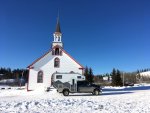

The cold weather front also meant clear skies and firm ice, so a mixed blessing. The next segment, once we regained the main winter road, took us to Fort Smith, NWT, via Wood Buffalo National Park. Although we could maintain 50 kph on the land portions before Fort Chip (speeds are restricted to 15 kph on water crossings), this bumpy, twisting section was best negotiated at 30 kph, often less. I was curious how we would handle oncoming vehicles on the narrow, tree-lined section but the only people we encountered were ice-fishing on the river.

Previous travels to the Arctic Ocean in summer impressed upon us the need for a robust, reliable and readily serviced platform so the choice of a domestic truck with suitable GVWR was a no-brainer.
The marriage of OEV’s premier Summit composite cabin with an F350 4x4 cab chassis seemed to answer our needs. Nevertheless, we took a year and a half to get familiar with the rig over several adventures during all seasons. This shake-down time was most worthwhile as we sorted a few glitches, but finally we were confident enough to tackle THE trip; the winter road to Fort Smith, Northwest Territories.
Winter roads in northern Canada have always fascinated us. As life-long residents of the city dubbed “Canada’s Gateway To The North”, we were taught in school about the fur trade and the use of rivers as highways through the barren landscape. For a couple of months each winter, when the ice was sufficiently thick on the rivers, dog-sleds would venture along their frozen surface. Nothing much has changed today for many remote settlements except canoes and dog-teams have been replaced by motorboats and snowmobiles.
Along a few select routes, crews and equipment prepare ice highways over the swamps, muskeg, creeks and rivers by pumping water on the frozen surface until a suitable thickness is achieved. These are stitched together by stretches of land wherever possible. During a brief and variable period each winter, entire communities are re-supplied for the coming year via the winter roads, at a fraction of the cost of air transport.
To prepare ourselves, we reviewed the highway department’s winter road safety tips; “Prepare for the worst, experience the best. Avoid traveling in winter storms as storms mean poor driving conditions and visibility. Conditions can change quickly. Make sure you are ready for whatever comes your way. Any delay or breakdown can quickly become life-threatening.”
Thus filled with confidence, we departed our home base one morning at the tail-end of February knowing that last season’s winter road was closed mid-March. Preparations were scant; a couple of jerry cans were filled with reassurance gas and an interior cargo net was installed in the rear seating area of our super cab, where some heavy gear was being carried. I packed snow chains but was relying on studded winter tires to deal with most situations.
The roadway gradually turned from dry pavement to fresh, wet, snow as we motored north towards our first stop of Fort McMurray, the hub of Alberta’s oil production. The lone highway accessing Fort Mac from the south is notorious for traffic fatalities as rig workers race up and down its 435 kilometres; impatient not to waste a single minute of their downtime. Death is forever, I’m thinking as another pickup flies by in the snow and ice-covered left lane…

To confess, this was our first trip to Fort McMurray and I was pleasantly impressed by the scenic Athabasca river valley bisecting the town. The cross-country ski facilities, some 30 km of groomed, wooded trails, invited us to take a day off and enjoy. An enormous vintage dredge at the Oil Sands Discovery Centre was clearly visible as we entered town but, unfortunately, was closed during the time of our visit.

Our night at the one RV campground open during winter was, as expected, empty of other tourists; occupied instead by units in storage and a handful of worker’s trailers, skirted and plumbed, for those few who chose not reside at the huge work camps outside of town. We would have preferred one of the provincial campgrounds but all were closed for the season. Regardless, the commercial RV park offered clean, warm shower and laundry facilities.
The real adventures began with the next leg of our travels, north to Fort Chipewyan. It started as a divided two-lane highway that services the gigantic oil sands extraction fields. After 80 km of sharing space with trucks big and small, the highways ends at a narrow track heading into the bush.




Fort Chipewyan is 160 km up the winter road and a further 16 km detour to the shores of Lake Athabasca. The community is only accessed by air or boat in summer and ice road in winter. Established as a fur trading post in 1788, it is also the oldest settlement in Alberta and remains the centre of First Nations activities in the region.
As we arrived under cold, bright blue skies we could easily observe the town buildings across the frozen lake and were puzzled by an unmarked branch which offered a more direct route to the settlement. Deciding to take this, I immediately sensed the surface heaving and creaking as we slowly motored along. At the other end a fellow driving a town vehicle congratulated us for braving their unofficial short-cut.

We took a tour through town while looking for gas and were impressed by the quads and snowmobiles sharing the streets. As I was stopped trying to figure out google directions, an oncoming truck pulled beside and a fellow asks if we needed help. Hearing our objective, he laughed and announced we had already passed the fuel depot. He suggested we reverse up the road; “I got your back”, he yelled and shot ahead to guide us safely into the yard. This was typical of the curiosity and helpfulness we were to consistently receive during our northern journey.
Two bucks a litre! That might explain a little incident at 1:30 am while boon-docking at the airport parking lot. Footsteps crunching in the snow were heard from the back where our jerry cans were securely locked in place. A loud motor peeling out of the parking lot announced their obvious disgust. Nevertheless, a huge shout-out to Ernest from the municipal maintenance department who offered us this otherwise comfortable roost for the night. As comfortable as you can be, that is, at -36°C (-32°F).


The cold weather front also meant clear skies and firm ice, so a mixed blessing. The next segment, once we regained the main winter road, took us to Fort Smith, NWT, via Wood Buffalo National Park. Although we could maintain 50 kph on the land portions before Fort Chip (speeds are restricted to 15 kph on water crossings), this bumpy, twisting section was best negotiated at 30 kph, often less. I was curious how we would handle oncoming vehicles on the narrow, tree-lined section but the only people we encountered were ice-fishing on the river.

Last edited:


